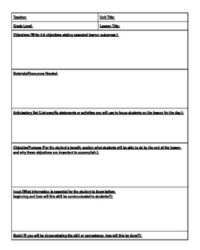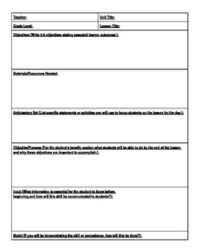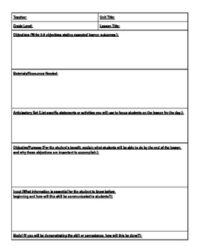Have you ever wondered what makes a truly effective lesson? What’s the secret sauce behind classrooms where students are engaged, learning is measurable, and teachers feel confident in their delivery? For decades, educators have found a powerful answer in the work of Dr. Madeline Hunter. Her framework for instructional design has provided a clear, logical structure that helps teachers plan lessons with purpose and precision. It’s more than just a sequence of activities; it’s a systematic approach to teaching that focuses on maximizing student learning.
Dr. Hunter’s model, often distilled into a "7-step lesson plan," empowers teachers to consider key elements of instruction before they even step into the classroom. It’s a pedagogical blueprint that ensures every minute of instruction counts, leading to deeper understanding and skill acquisition for students. Whether you’re a seasoned educator looking to refine your practice or a new teacher seeking a robust foundation, understanding this framework can transform your approach to lesson planning and delivery.
Understanding the Foundation: The 7 Elements of Hunter’s Framework
Dr. Madeline Hunter’s approach to lesson design is often referred to as the "7-step lesson plan," but it’s perhaps more accurately understood as seven essential instructional elements. These elements provide a comprehensive guide for teachers to plan and execute lessons that are clear, engaging, and highly effective. They are not rigid, unyielding steps to be followed blindly, but rather a flexible framework that ensures all critical components of an effective lesson are considered and addressed. The beauty of Hunter’s model lies in its logical progression, guiding students from initial engagement to independent mastery.
The pedagogical rationale behind these elements is rooted in cognitive psychology and educational best practices. Hunter emphasized that effective instruction requires teachers to actively manage learning, provide timely feedback, and ensure students are truly comprehending the material. By systematically addressing each element, teachers can create a learning environment where students know what’s expected, understand the content, and have ample opportunities to practice and apply their new knowledge and skills. It’s about structuring the learning experience in a way that aligns with how the human brain processes and retains information.
The Core 7 Instructional Elements Explained
Here’s a closer look at each crucial component that makes up the Madeline Hunter 7 step lesson plan template. It’s important to remember that while these are presented sequentially, the art of teaching often involves fluidity and revisiting steps as needed:
- Anticipatory Set
- Objective
- Input
- Check for Understanding
- Guided Practice
- Independent Practice
- Closure
Let’s delve into the initial components. The Anticipatory Set is all about hooking your students right from the start. It’s that warm-up activity, a thought-provoking question, a short video, or a brief discussion designed to grab their attention and connect the new lesson to their prior knowledge or experiences. This step creates relevance and curiosity, making students eager to learn. Following this, the Objective clearly defines what students will learn or be able to do by the end of the lesson. These learning targets should be specific, measurable, achievable, relevant, and time-bound (SMART), providing a clear roadmap for both teacher and student. Next comes Input, where the teacher presents the new information, concepts, or skills. This often includes direct instruction, explaining terms, providing examples, or demonstrating a process. Input can take various forms, such as lectures, readings, videos, or hands-on explorations. Integral to Input is also often Modeling, where the teacher explicitly shows students how to perform a task or apply a concept, making the learning visible.
After presenting new information, the Check for Understanding step is vital. This isn’t just a formal assessment at the end; it’s an ongoing process throughout the lesson where the teacher continually monitors student comprehension. This can involve asking questions, observing student work, using quick formative assessments, or having students explain concepts in their own words. It helps the teacher identify misconceptions early and adjust instruction as needed. Following this, Guided Practice provides students with an opportunity to try out the new skill or apply the concept with teacher support and feedback. This is where students work together or individually under the teacher’s watchful eye, allowing for immediate correction and reinforcement. It’s a safe space to make mistakes and learn from them.
Finally, the lesson moves towards independent application and consolidation. Independent Practice gives students the chance to apply what they’ve learned without direct teacher supervision. This step is crucial for solidifying understanding and building confidence. It could involve homework, a project, a lab activity, or individual problem-solving. It’s a true test of their mastery. The lesson concludes with Closure, a brief summary or wrap-up activity that helps students synthesize what they’ve learned. It’s a moment to review the main points, connect them back to the objective, and prepare students for what comes next. This step ensures that students leave the lesson with a clear understanding of the key takeaways and how they fit into the bigger picture.
Why This Framework Still Matters for Modern Educators
In an ever-evolving educational landscape, the core principles of Dr. Madeline Hunter’s instructional framework remain remarkably relevant. While teaching methodologies and technologies have advanced, the fundamental need for structured, purposeful learning experiences has not changed. This framework provides a timeless template that helps educators, whether teaching in a traditional classroom or a hybrid environment, to maintain focus on the learner’s journey from initial exposure to confident mastery. It encourages thoughtful preparation, moving beyond simply "covering" material to ensuring genuine student understanding and skill development.
One of the most significant benefits of applying this model is its contribution to clarity and engagement. By focusing on explicit objectives, presenting content clearly, and providing ample opportunities for practice, teachers create a predictable yet dynamic learning environment. Students benefit from knowing what they are expected to learn and how they will demonstrate that learning. This structured approach also naturally integrates various forms of assessment, not just as a final test, but as ongoing checks for understanding throughout the lesson. This continuous feedback loop is invaluable for both students to gauge their progress and for teachers to adapt their instruction on the fly.
The adaptability of the Madeline Hunter framework is another reason for its enduring popularity. It’s not prescriptive about content or specific activities but rather about the sequence of effective instruction. This means it can be applied across all subject areas—from math and science to language arts and social studies—and adapted for various grade levels and learning styles. Modern educators can easily integrate technology, collaborative projects, and differentiated instruction within this structured approach, proving that a solid foundation in instructional design is timeless.
Here are some key benefits this framework offers:
- Clarity in Instruction: Provides a clear roadmap for both teachers and students.
- Student Engagement: Fosters active participation through structured activities and checks for understanding.
- Effective Assessment Integration: Embeds continuous monitoring of student comprehension.
- Adaptability: Applicable across diverse subjects, grade levels, and teaching methodologies.
- Maximized Learning: Ensures a logical progression from introduction to independent mastery.
Embracing the principles of the Madeline Hunter framework means prioritizing deliberate planning and thoughtful execution in every lesson. It’s about building a strong foundation for learning, ensuring that students are not just passive recipients of information but active participants in their own educational journey. By consistently applying these instructional elements, educators can create dynamic and effective learning experiences that truly resonate with their students.
Ultimately, the goal of any lesson is to facilitate meaningful learning. The structured yet flexible nature of this framework provides a powerful tool for achieving that. It encourages teachers to think critically about how students learn best, how to present information effectively, and how to provide the right balance of support and challenge. By integrating these well-established principles into daily practice, educators can consistently deliver high-quality instruction that leads to measurable student success and a more confident, prepared teaching approach.


